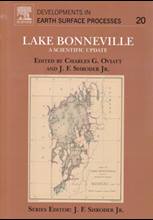
Lake Bonneville and its first monographer, Grove Karl Gilbert, are like beacons in the history of studies examining evidence for long-term climate change in the Quaternary Period. In the first Monograph of the United States Geological Survey published in 1890, Gilbert meticulously described the regional landforms of Lake Bonneville and outlined the evidence for the changing lake-fill history and other geomorphological changes within the region.
The present volume provides a detailed update, based on numerous studies involving technologies such as geochemistry, geochronology (radiocarbon, cosmogenic nuclide dating), remote sensing and spatial analysis not available in Gilbert’s day. It also builds upon and integrates the observations of countless researchers since Gilbert’s seminal publication. The volume provides a template to evaluate many of Gilbert’s hypotheses about the geomorphological evolution of the region, particularly in terms of more quantitative information.
At its zenith, Lake Bonneville, a pluvial lake, covered an area of approximately 50,000 km
2 in what is now north-western Utah and parts of south-eastern Nevada. Named after Captain B. L. E. Bonneville who first explored the region in the 1830s, the lake developed and shrank during the Last Glacial Maximum at a time of increasing development of the Laurentide and Cordilleran ice sheets. The lake’s presence at the time of substantial ice sheet development would at first appear enigmatic, but resulted in part from the diversion of the Bear River on the north-eastern margin of the enclosed depression of Lake Bonneville. The river diversion resulted from an episode of volcanism in the Blackfoot-Gem Valley volcanic field and led to a substantial inflow of water to Lake Bonneville. As the lake system filled, a succession of higher lake shorelines developed with the transgression culminating in the Bonneville shoreline, some 300 m above the elevation of the Great Salt Lake at Salt Lake City.
This really is a wonderful volume providing a wealth of quantitative information about the long-term development of Lake Bonneville. The topics covered are diverse and focus on specific lake shoreline successions (Provo, Bonneville), the history of the Bear River, landslides, alluvial fans and dam failure, changes in climate and vegetation, fishes, avifauna, vegetation changes, water chemistry, mountain glaciation within the Bonneville Basin, early human occupation of the region, application of high-resolution seismic reflection and remote sensing to better characterise the lake system, and Lake Bonneville geosites within an urban landscape. The book is a fitting tribute to the pioneering work of Gilbert and one is left wondering what he would make of this delightful and very informative volume.
Reviewed by Colin V. Murray-Wallace
LAKE BONNEVILLE: A SCIENTIFIC UPDATE, by Charles G. Oviatt & J. F. Shroder JR (Eds), 2016, Published by Elsevier, 659 pp. (hbk) ISBN: 978-0-444-63590-7. List Price: £121.00. W:
www.elsevier.com